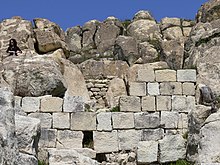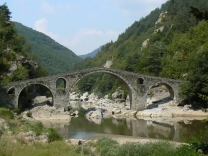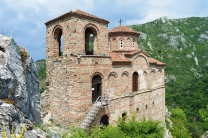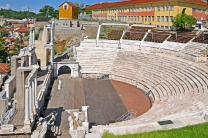No video yet

Perperikon
The ancient Thracian city of Perperikon (also Perpericon; Bulgarian: Перперикон, Greek: Περπερικόν) is located in the Eastern Rhodopes, 15 km northeast of the present-day town of Kardzhali, Bulgaria, on a 470 m high rocky hill, which is thought to have been a sacred place. The village of Gorna krepost ("Upper Fortress") is located at the foot of the hill and the gold-bearing Perpereshka River flows nearby. Perperikon is the largest megalith ensemble site in the Balkans.
The name "Perperikon"
The name Perperikon dates from the Middle Ages – 11th–13th centuries. The original name Hyperperakion was shortened by scribes to Perperakion or Perperikon. There are at least two theories about the origin and meaning of the name, both associating it with gold-mining: The city may have been named after a Medieval high-temperature gold-refining process (Medieval Greek hyperpyros), or the resumed use of a classical-era name for the site, derived from a word for altar-fire (ancient Greek hyperpyros).
History
Human activity in the area dates back to 5000 BCE. The first traces of civilization on the hill date from the Bronze Age, while the ceramics found on the place date from the Early Iron Age, as well as the impressive round altar, almost 2 m in diameter, hewn out of the rocks.
It is thought that a famous Temple of Dionysius was located at Perperikon during the classical era.
Perperikon is the site from which Medokos declared himself the king of Thrace in 424 BCE, after Sitalces's death, but was overthrown.
Bulgarian archaeologist Nikolay Ovcharov started the excavation works at Perperikon in 2000, and revealed the remains of ancient architectural complex.
Archaeologists have uncovered a giant multi-story palace and an imposing fortress built around the hill, with walls as thick as 2.8 m. This dates from the time of the Roman Empire. Temples and residential quarters were also constructed in the fortress. The megalithic complex has been laid in ruins and re-erected many times throughout history.
A 2.4 million Euro visitor centre is being constructed with funds provided by...









